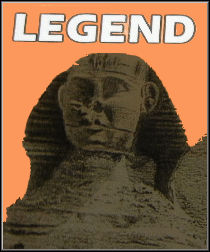
CXG Legend picture taken from the box front.
The CXG Sphinx Legend chess program was created by the Hungarian programmer Guyla Horvath and is based on his “Pandix” program that won the amateur world championship in 1987.
The normal out of the box playing style is a little passive but you do have the ability to change its play in 9 styles ranging from ultra-cautious play when the program is WHITE and ultra-aggressive play when it is BLACK (style number 1), to ultra-aggressive play when the program is WHITE and ultra-cautious play when it is BLACK (style number 9). The normal style is style number 5.
The CXG Sphinx Legend also has some other interesting features:
WHY NOT?
After the computer has made a move you can ask it the question: “Why did you not play ......?” and suggest a different move. The computer will then tell you what it expected you to play in reply if it had chosen your suggested move. (This will not always be the best move but it will be a move which the computer considered strong enough to counteract your suggested move.)

This logo was typically used on a CXG Chess Computer box
USER PROGRAMMABLE EVALUATION FUNCTION
Every chess program needs to know how to evaluate a chess position. It does so using an Evaluation Function which gives a point-score to various features of the position, such as king attack, material, mobility, center control, etc. Associated with each of these features is a “weighting” which tells the program how much importance to attach to a feature.
The Sphinx Legend allows you to change these weightings so that you, the user, are programming the computer to play in a particular way. For each feature the minimum weighting is 0 (when this feature would be completely ignored) and the maximum weighting is 99 (when the feature will be given 10 times its normal importance).
The normal factory out of the box weighting is 50 for all of these features. There are 7 features in total where the weightings can be adjusted from 0 to 99:
- Pin against the enemy Queen.
- Pawn structure around the King.
- King attack by pieces.
- Aggressive play by White’s pieces.
- Aggessive play by Black’s pieces.
- Doubled pawns.
- Rooks on open and half open files.
Partial excerpts taken out of the CXG Legend User Manual.

This picture is taken from the CXG Legend Box. In the United States Excalibur Electronics marketed the CXG Legend. This also explains why Excalibur Electronics later named their own slightly different designed version as Excalibur Legend II. Both computers are identical in playing strength. Only the electronic board looks different.

Technical Specification
CXG Sphinx Legend (1992)



Box
User Manual
LCD Display
Spacious Mind
Schachcomputer.Info
Active 2017
Tourn. 2015
1792
-
T1
T2
T3
T4
T5
Final
2028
2068
2258
1914
1934
2054
MANUFACTURER
PROGRAMMER
CXG / Newcrest Technology Ltd.
Gyula Horvath
1950 European
1992
$129,00
1800
Year:
MFR ELO:
Original Price:
Wiki ELO:
Model #:
CXG - 603
My Serial #:
Not Available
Processor OEM
Hitachi
Processor:
H8
Speed:
Type:
8 Bit
10 MHz
ROM:
32 KB
RAM:
1 KB
Battery Type:
4 x AA
Power Adapter:
9V DC 5 mA
Display:
16 Board LEDs
Board Type:
Press Sensory
Overall Size:
Board Size:
8x8 in
11x9.1/2x1
Options Select:
Button Select
Play Levels:
100
Opening Book:
3000 Positions
Take Back:
16 Half Moves
Position Setup:
Available
Position Verify:
Available
Move Analysis:
Display Info:
Available
Available
Solve Mate:
Mate in 6
Save Game:
Available
Ponder:
Available
Search Depth:
Not Known
Provide Hint:
Available
Teach Mode:
Available
Change Sides:
Available
Active Level:
TM Level:
93
Infinite Level:
94
53
Hardware Specification
Game Features
Matchplay & Test ELO Ratings
Computer Game Rating
Rating Test
Other Computer Chess Ratings
USCF
USCF
Spacious Mind
Human Rating
USCF
CCR 95
CCNS
Ply
FIDE
USCF
1985
-
-
1861
1878
Class A Level Electronic Table Top Chess Computer!

